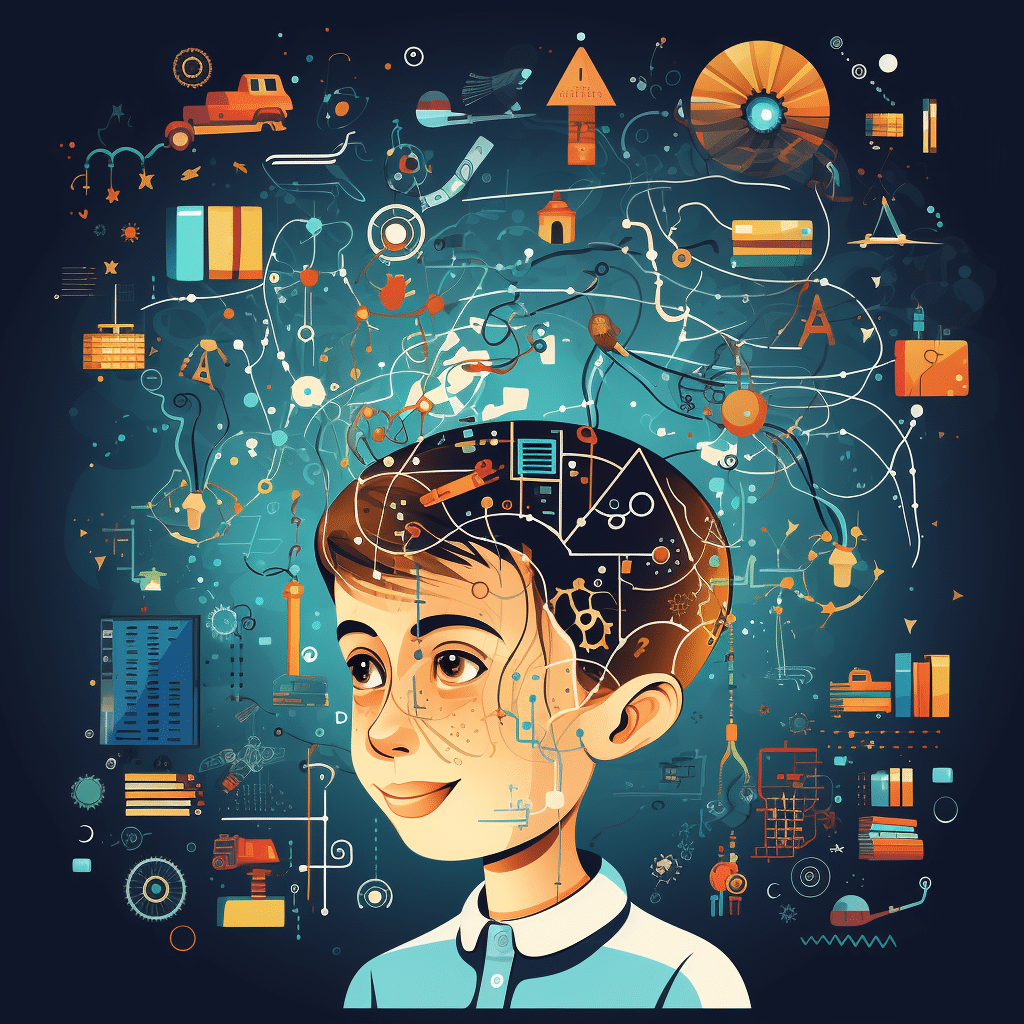
AI in Education: Personalized Learning for Students
The integration of Artificial Intelligence (AI) in education has transformed the traditional learning landscape, empowering students with personalized and dynamic learning experiences. AI technology adapts to an individual student’s needs, enhancing their understanding and promoting engagement. This article explores the potential of AI in delivering personalized learning for students.
The Power of Personalization

AI algorithms analyze vast amounts of data, such as students’ learning patterns, preferences, and performance. With this information, AI systems generate tailored content and adapt teaching methods to suit each student’s unique learning style. Personalized learning provides several advantages:
-
- Enhanced engagement and motivation as students receive content relevant to their interests and abilities.
-
- Individual pace allows students to learn at their own speed, promoting better understanding and reducing anxiety.
-
- Identifying knowledge gaps and misconceptions to provide targeted interventions and improving overall learning outcomes.
AI-Based Learning Assistants
AI-powered virtual assistants, such as chatbots or voice-activated tools, are becoming prominent in classrooms. These learning companions offer real-time support and foster independent learning. They can:
-
- Answer students’ questions and provide immediate feedback.
-
- Suggest relevant learning resources based on individual needs.
-
- Offer personalized study plans and track progress.
Big Data and Analytics in Education
AI enables the collection and analysis of vast amounts of data, offering valuable insights into students’ learning behaviors and the effectiveness of teaching approaches. With this information, educators can:
-
- Identify struggling students and provide timely interventions.
-
- Track progress and adjust teaching strategies accordingly.
-
- Improve curriculum development to address specific learning needs.
Ethical Concerns and the Human Touch

While AI in education provides numerous benefits, it poses ethical considerations. Striking a balance between technology and a human touch is vital. Teachers play a crucial role in leveraging AI effectively:
-
- Guiding students to use AI tools responsibly and encouraging critical thinking skills.
-
- Providing emotional support, motivation, and fostering interpersonal skills.
-
- Ensuring inclusivity and fairness in AI algorithms and avoiding perpetuating bias.
“Education is not solely about knowledge absorption; it is about shaping minds and nurturing holistic development.”
Conclusion
AI is revolutionizing education by delivering personalized learning experiences for students. The power of personalization, AI-based learning assistants, big data analytics, and the human touch collectively shape a future where education meets the needs of every student, ensuring equitable and meaningful learning opportunities.
How can artificial intelligence improve personalized learning for students in education?
There are several ways in which artificial intelligence (AI) can enhance personalized learning for students in education:
1. Adaptive learning platforms:
AI can analyze student performance data and customize the learning experience based on individual strengths and weaknesses. It can identify areas where a student may be struggling and provide additional resources or targeted instruction to address those gaps.
2. Intelligent tutoring systems:
AI-powered virtual tutors can offer personalized guidance and support to students. These systems can assist learners in problem-solving, provide immediate feedback, and adapt the learning pace as per individual needs.
3. Individualized content delivery:
AI algorithms can analyze a student’s learning preferences, interests, and previous achievements to provide tailored educational content. This ensures students receive information in a format and style that suits their learning style, promoting greater engagement and understanding.
4. Enhanced assessment and feedback:
AI can automate the grading process and provide detailed and timely feedback to students. It can analyze student responses, identify common misconceptions, and offer personalized suggestions for improvement.
5. Intelligent learning analytics:
AI algorithms can analyze vast amounts of data collected from various sources, such as assessments, attendance records, and student behavior. These analytics can provide educators with insights into student progress, identify patterns, and offer recommendations for personalized intervention.
6. Virtual simulations and augmented reality:
AI technologies can create virtual learning environments and simulations that enable students to engage in realistic, hands-on experiences. This allows for personalized and immersive learning, especially in subjects such as science, engineering, and healthcare.
7. Natural language processing:
AI-powered chatbots and virtual assistants can respond to student inquiries, provide explanations, and offer personalized guidance. These tools can assist students both inside and outside the classroom, enhancing accessibility and support.
Overall, leveraging AI can help create more individualized and effective learning experiences, tailored to the unique needs and abilities of each student.
How can AI be utilized to ensure equity in personalized learning opportunities for all students in education
AI can play a crucial role in ensuring equity in personalized learning opportunities for all students in education. Here are some ways in which AI can be utilized:
1. Tailored and adaptive learning:
AI-powered algorithms can analyze students’ learning patterns, preferences, and abilities to provide personalized recommendations and resources. This ensures that each student receives content and resources suitable for their unique needs, fostering equitable access to educational opportunities.
2. Intelligent tutoring systems:
AI-based tutoring systems can provide personalized assistance to students, guiding them through their learning journey. These systems can identify areas where students struggle and adapt instruction accordingly, providing additional support or resources as needed. This helps level the playing field for students who may require extra assistance.
3. Learning analytics:
AI can collect and analyze vast amounts of data from different students to identify trends, patterns, and disparities in their learning outcomes. This data can be used to identify areas where certain groups of students are not receiving equitable opportunities and inform interventions to address these gaps.
4. Language processing and translation:
AI-powered language processing capabilities can facilitate communication with students who are non-native English speakers or have disabilities that impact their communication. This ensures they have equal access to information and resources.
5. Automated assessment and feedback:
AI can automate aspects of assessment and feedback, making it more efficient and unbiased. By removing human biases, AI can provide fair and objective evaluations for all students, ensuring equity in assessments.
6. Digital accessibility:
AI technology can be leveraged to make educational content more accessible for students with disabilities. For example, AI-powered tools can convert text to speech or provide alternative formats, making sure students with visual impairments can equally engage with the material.
Overall, AI can help bridge the equity gap in personalized learning opportunities by providing tailored instruction, adapting to individual needs, and ensuring fair assessment and access to resources for all students.
What are the benefits of using AI in education to deliver personalized learning experiences?
– Personalized learning experiences:
AI can analyze and understand the individual learning needs of students, allowing for the creation of personalized learning paths tailored to their specific strengths and weaknesses. This can enhance student engagement and motivation, as they receive content and instructions that are relevant to their unique learning styles.
– Adaptive learning:
AI algorithms can adapt and adjust teaching methods in real-time based on the student’s progress and performance. This adaptive learning approach ensures that students are constantly challenged but not overwhelmed, leading to improved retention and mastery of the material.
– Efficient and scalable:
AI-powered educational platforms can handle large amounts of data and deliver personalized feedback and guidance to a large number of students simultaneously. This scalability allows for more efficient use of teachers’ time and resources, as they can focus on supporting students who require additional assistance.
– Continuous assessment:
AI can continuously assess a student’s understanding and progress, providing instant feedback and identifying areas where the student might need additional help. This real-time assessment helps students to address their weaknesses promptly and facilitates targeted intervention.
– Enhanced accessibility and inclusivity:
AI can provide accommodations and support for students with different learning abilities. For example, it can assist students with disabilities by offering text-to-speech features, adaptive curriculum, and speech recognition capabilities. This ensures that education is accessible and inclusive for all learners.
– Data-driven insights:
AI can collect and analyze vast amounts of data on student performance, learning patterns, and preferences. Educators can then use these insights to make informed decisions about curriculum development, teaching strategies, and interventions to improve learning outcomes.
– Lifelong learning and personal growth:
AI can support lifelong learning by tracking individual progress, identifying gaps in knowledge, and providing recommendations for further learning. This personalized approach encourages students to take ownership of their education and fosters a mindset of continuous improvement.
Overall, the benefits of using AI in education to deliver personalized learning experiences include improved student engagement, enhanced learning outcomes, efficient use of resources, increased accessibility, and data-driven insights for continuous improvement.









Can you be more specific about the content of your article? After reading it, I still have some doubts. Hope you can help me.
Thank you for your sharing. I am worried that I lack creative ideas. It is your article that makes me full of hope. Thank you. But, I have a question, can you help me?